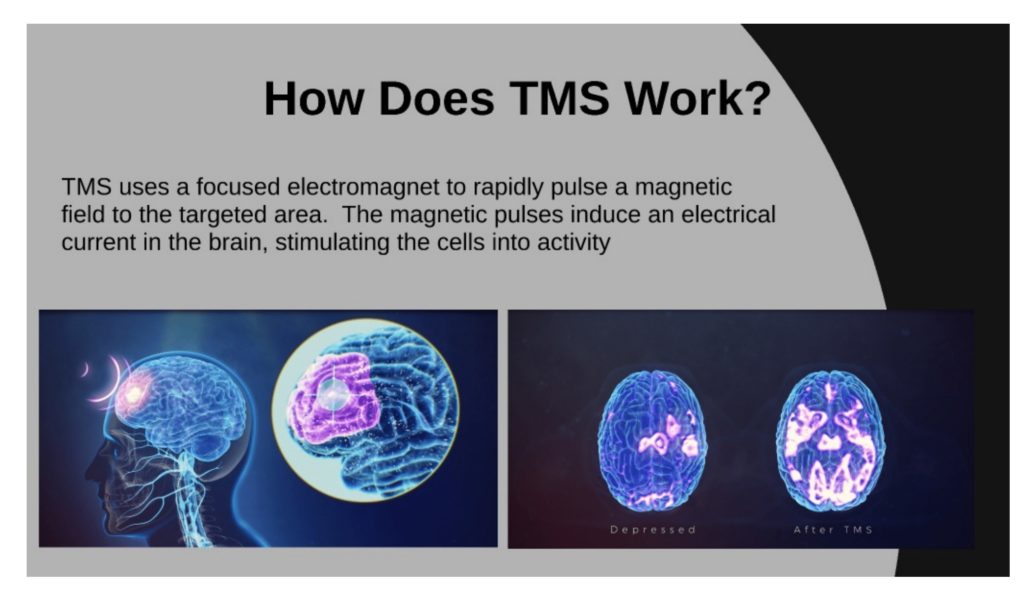
Transcranial Magnetic Stimulation (TMS) Therapy

According to WHO, Depression is a common illness worldwide, with more than 300 million people affected. Depression is different from usual mood fluctuations and short-lived emotional responses to challenges in everyday life. Especially when long-lasting and with moderate or severe intensity, depression may become a serious health condition. It can cause the affected person to suffer greatly and function poorly at work, at school and in the family. At its worst, depression can lead to suicide. Close to 800 000 people die due to suicide every year. Suicide is the second leading cause of death in 15-29-year-olds.
While there are many effective treatments for depression, first-line approaches such as antidepressants and psychotherapy do not work for everyone. In fact, approximately two-thirds of people with depression don’t get adequate relief from the first antidepressant they try. After two months of treatment, at least some symptoms will remain for these individuals, and each subsequent medication tried is actually less likely to help than the one prior.
What can people with depression do when they do not respond to first-line treatments? For those individuals and the many others who have had an inadequate response to medications and therapy alone, there is a newer treatment option called transcranial magnetic stimulation (TMS).
What is TMS?
Transcranial magnetic stimulation (TMS) is a noninvasive procedure that uses magnetic fields to stimulate nerve cells in the brain to improve symptoms of depression. TMS is typically used when other depression treatments haven’t been effective.
This treatment for depression involves delivering repetitive magnetic pulses, so it’s called repetitive TMS or rTMS.
How does it work?
During an rTMS session, an electromagnetic coil is placed against your scalp near your forehead. The electromagnet painlessly delivers a magnetic pulse that stimulates the nerve cells in the region of your brain involved in mood control and depression. It’s thought to activate regions of the brain that have decreased activity in depression.
What are the different types of TMS treatments available?
Repetitive transcranial magnetic stimulation (rTMS)
- rTMS is used to treat patients with unipolar depression.
- In rTMS an electromagnetic coil is held against the patient’s left side of the scalp while short electromagnetic pulses are administered through the coil. The magnetic and repeating pulses cause small electrical currents that stimulate nerve cells in the targeted region of the brain.
Deep transcranial magnetic stimulation (dTMS)
- The procedure uses specialized coils, called H coils, which reach about 2 inches beneath the surface of the skull and are designed to target different brain areas.
- During a dTMS session, a person wears a cushioned helmet, which generates brief magnetic fields.
- dTMS is used to treat patients with unipolar depression and obsessive compulsive disorder.
Risks
Repetitive TMS is a noninvasive form of brain stimulation used for depression. Unlike vagus nerve stimulation or deep brain stimulation, rTMS does not require surgery or implantation of electrodes. And, unlike electroconvulsive therapy (ECT), rTMS doesn’t cause seizures or require sedation with anesthesia.
Generally, rTMS is considered safe and well-tolerated. However, it can cause some side effects.
Common side effects
Side effects are generally mild to moderate and improve shortly after an individual session and decrease over time with additional sessions. They may include headache, scalp discomfort at the site of stimulation, tingling, spasms or twitching of facial muscles, lightheadedness
Your doctor can adjust the level of stimulation to reduce symptoms or may recommend that you take an over-the-counter pain medication before the procedure.
Uncommon side effects
Serious side effects are rare. They may include Seizures, Mania, particularly in people with bipolar disorder, Hearing loss if there is inadequate ear protection during treatment
Preparation
Before having rTMS, you may need a physical exam and possibly lab tests or other tests and a Psychiatric evaluation to discuss your depression. These evaluations help make sure that rTMS is safe and a good option for you.
Tell your doctor or mental health provider if you are pregnant or thinking of becoming pregnant, if you have any metal or implanted medical devices in your body. In some cases, people with metal implants or devices can have rTMS. However, due to the strong magnetic field produced during rTMS, the procedure is not recommended for some people who have the following devices such as Aneurysm clips or coils, Stents, implanted vagus nerve or deep brain stimulators, implanted electrical devices, such as pacemakers or medication pumps, electrodes for monitoring brain activity, Cochlear implants for hearing, any magnetic implants, bullet fragments or any other metal device or object implanted in your body. Also let your doctor know if you are taking any medications, if you have a history of seizures or a family history of epilepsy, if you have other mental health disorders, if you have brain damage from illness or injury, such as a brain tumor, a stroke or traumatic brain injury, if you have frequent or severe headaches, you have any other medical conditions, or you have had prior treatment with TMS, and whether it was helpful in treating your depression.
Repetitive TMS isn’t invasive, doesn’t require anesthesia and can be performed on an outpatient basis. You don’t need to arrange for someone to drive you home after treatment — unless, for the first treatment, you prefer a driver until you get a sense of how you’ll feel afterward.
Before considering treatment, check with your health insurance company to see whether rTMS is covered. Your policy may not cover it.
Repetitive TMS is usually done in a doctor’s office or clinic. It requires a series of treatment sessions to be effective. Generally, sessions are carried out daily, five times a week for four to six weeks.
After each treatment you can return to your normal daily activities after your treatment. Typically, between treatments, you can expect to work and drive.
Does TMS work?
Approximately 50% to 60% of people with depression who have tried and failed to receive benefit from medications experience a clinically meaningful response with TMS. About one-third of these individuals experience a full remission, meaning that their symptoms go away completely. It is important to acknowledge that these results, while encouraging, are not permanent. Like most other treatments for mood disorders, there is a high recurrence rate. However, most TMS patients feel better for many months after treatment stops, with the average length of response being a little more than a year. Some will opt to come back for subsequent rounds of treatment. For individuals who do not respond to TMS, ECT may still be effective and is often worth considering.
Can TMS help with other conditions?
TMS is being studied extensively across disorders and even disciplines with the hope that it will evolve into new treatments for neurological disorders, pain management, and physical rehabilitation in addition to psychiatry. There are currently large clinical trials looking at the effectiveness of TMS in conditions such as pediatric depression, bipolar disorder, smoking cessation, and post-traumatic stress disorder. While promising avenues for research, TMS for these conditions is not yet approved and would be considered “off-label.”

